Montessori reading is a part of the Montessori parenting method developed by Dr. Maria Montessori in the early 20th century. Based on self-directed activities, hands-on learning and collaborative play, the method focuses on children’s natural learning tendencies.
Basically, Dr. Maria Montessori observed that children learn best when they are provided with adequate, age-appropriate tools, such as a supportive, sensory-rich environment.
The concept remains the same regardless of the developmental area.
In particular, the Montessori reading approach stimulates children’s love for reading and makes it fun, interactive and beneficial. With the use of various materials and activities, such as phonemes, the Montessori method makes words and languages exciting.
The idea lies in inspiring children to read on their own. Montessori reading cultivates a lifelong love for learning and reading by providing a positive environment in which kids have plenty of instrumental opportunities and experiences to hone their language skills.
It’s all about setting the stage. Montessori reading, as part of the larger Montessori education method, focuses on giving the children freedom and resources necessary for them to gain language skills and develop their understanding of words at their own pace.
Since every child learns at a difference pace, the Montessori method encourages parents and teachers to stay flexible and adaptive with children that learn more slowly or quickly.
Montessori reading is a unique and dynamic approach to education, but it’s not the only teaching and parenting method. Therefore, it’s important for parents to familiarize themselves with alternative methods, too, as they work to find the best strategies.
Teaching Reading: The Montessori Way

Teaching writing and reading begins early. However, a calculated head start doesn’t guarantee early results. Most kids learn how to read by age 6 or 7. Yes, some kids learn to read much sooner, but it’s important that parents respect their child’s learning pace.
Understanding the Montessori method implies grasping the guiding steps of Montessori.
The way the Montessori reading works is that it encompasses several key concepts and principles that parents and teachers have to follow carefully. In a Montessori classroom, reading and writing classes are typically introduced around the age of 3 or 4 years.
During this time, a child is placed in a developmental environment that utilizes a sensorial, hands-on approach as opposed to having parents and teachers give direct instructions.
There are four key principles of the Montessori reading method:
- A sensorial approach to learning.
- The importance of phonetic sounds.
- The development of language skills.
- Encouraging a love for reading.
By understanding how these principles work individually and the ways by which they intertwine in order to contribute to your child’s development efficiently, the idea behind the Montessori way of teaching reading becomes much clearer and comprehensible.
Therefore, let’s examine these key principles, one by one.
1. Sensory-Based Reading: The Montessori Way

The Montessori reading style focuses on activating the senses. What does that mean? Well, it encompasses a wide range of teaching techniques. Specifically, it implies that children are provided opportunities in which they can engage with letters and words.
Having a sensory-rich environment is, therefore, a must.
Besides letters and words, it’s crucial that kids have a way to interact with sounds.
Sensory learning usually utilizes tools and resources specifically designed for stimulated engagement. For example, giving kids sandpaper letters allows them to feel the shape of the letters, after which they know how to associate letters with corresponding sounds.
This method stimulates children’s muscular and visual memory.
This is precisely what we mean when we’re talking about a hands-on approach. Even though a teacher or a parent is present for guidance, children have all the tools they need to learn on their own, which further empowers their ability to comprehend symbols.
Additional sensory activities include a variety of sound games and phonetic exercises. A movable alphabet, for example, is also a useful tool for teaching reading, spelling and writing, which helps a child make meaningful connections and progress adequately.
The purpose of activating the senses is to help children understand the subtle and not-so-subtle differences and connections between what they see, hear and feel. Mastering these differences leads to a better understanding of words and refines their reading skills.
Most of all, these types of sensory games and activities are extremely fun. Since they’re fun, exciting and engaging, kids naturally begin to associate such tasks with playtime.
This inevitably helps kids develop a lifelong love and passion not only for reading, but for learning. That’s the key takeaway and the very foundation of the Montessori method.
2. Phonetic Sounds: The Montessori Way
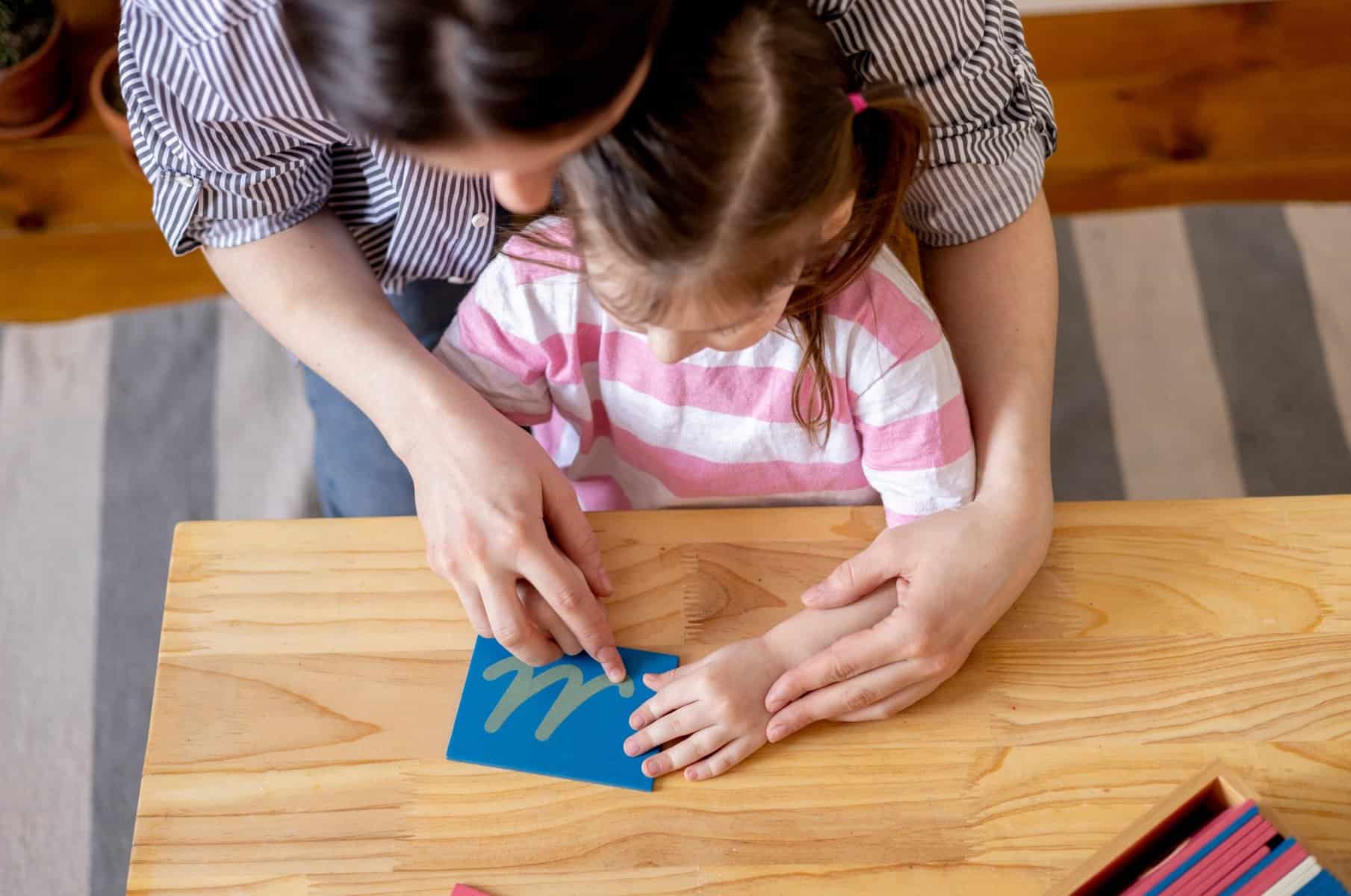
In a Montessori school, children grasp how to associate sounds with individual letters.
In fact, the emphasis on the development of phonemic awareness is highly prioritized. Children first have to grasp to associate sounds with their corresponding symbols in a way that allows them to string individual letters together in order to form coherent words.
The better they get at understanding phonetics, the sooner they understand how to decipher words by blending individual letters together in order to form complete words.
In Montessori schools, there is a strong emphasis on helping kids understand how to read by sounding words, rather than memorizing words, which has proven to be a successful formula for helping children develop their vocabulary on a significantly deeper level.
But, how exactly does the Montessori reading style teach phonetics?
Similarly to any area of development, Montessori schools teach letters and phonetic sounds by way of hands-on activities. So, it’s crucial that parents or teachers provide adequate assets, resources or books that focus on the idea of matching sounds.
For example, to help a child refine their auditory sense and memory, you can use so-called sound boxes, which focus on the idea of blending sounds in order to make words.
Basically any play games or activities that reinforce and empower a child’s understanding of phonetics and how they work in relation to words is a good way to teach reading.
Together, sensory activities and phonetic sounds build a strong foundation for literature. Little by little, as the child learns to identify individual sounds and letters with the help of the Montessori reading method, they learn to decode words and use them comfortably.
3. Developing Language Skills: The Montessori Way
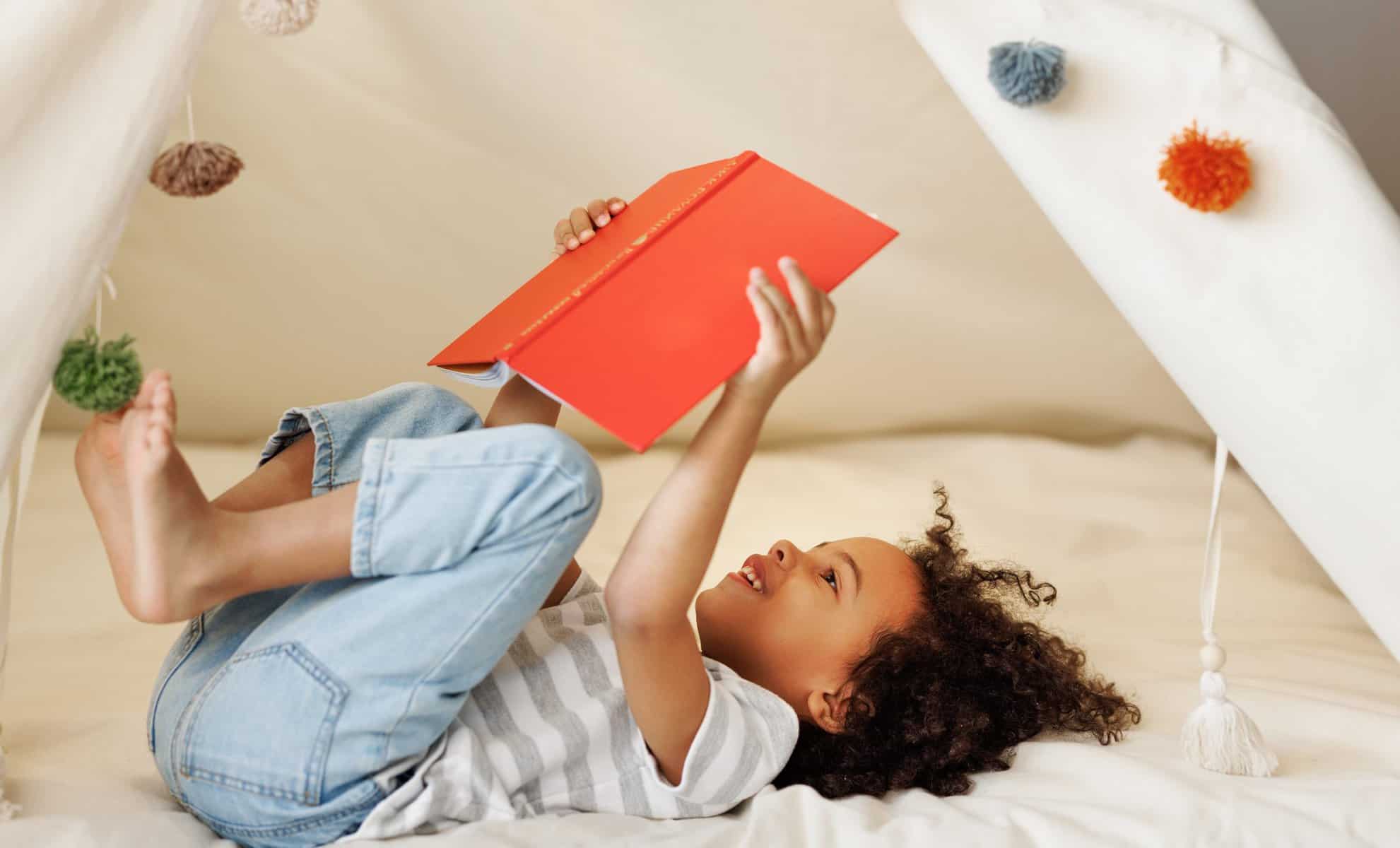
The central focus point in Montessori reading is, of course, language development.
In that regard, the Montessori style acknowledges writing and reading as complex processes that have to be developed carefully with a lot of age-appropriate hands-on activities that properly stimulate development in a safe and comfortable environment.
It’s all about establishing the right kind of foundation for knowledge.
Teaching a child to read is multi-layered. It’s not as simple as having them sit down and telling them to read words or reading words out to them. No, it’s actually about teaching individual letters and corresponding sounds, as well as expanding actual language skills.
Now, language involves three things: speaking, listening and writing. These three aspects have to work fluidly and cohesively. Precisely, they have to be developed simultaneously.
In a Montessori school, children are provided adequate tools and activities they need so as to become confident readers. It’s not the matter of a child just reading words out loud, but a matter of understanding what the actual word means – it’s about comprehension.
In order to practice the Montessori reading method, children are provided multiple opportunities to engage in conversations, to participate in stimulating language-rich activities, to listen to stories and songs and to learn how to decode words and letters.
With all of these activities combined, kids naturally expand their vocabulary.
Whether at home or at a school classroom, the Montessori style relies on materials. But, what kind of resources do you need to help children connect a letter to a sound? Overall, these resources include a variety of books, signs, labels and extra written materials.
Placing kids in a writing-rich environment actively promotes their learning.
In a Montessori classroom, it’s all about doing things creatively. A great way to expand their language skills is to inspire them to do a little bit of independent storytelling. Telling stories stimulates their imagination and helps them actively develop self-confidence.
All in all, it’s not only about learning letters and phonetics with the Montessori method, but about a variety of activities and learning opportunities that work fluidly together to set children on a path towards literacy and finer comprehension of writing and reading.
4. Cultivating a Love of Reading: The Montessori Way
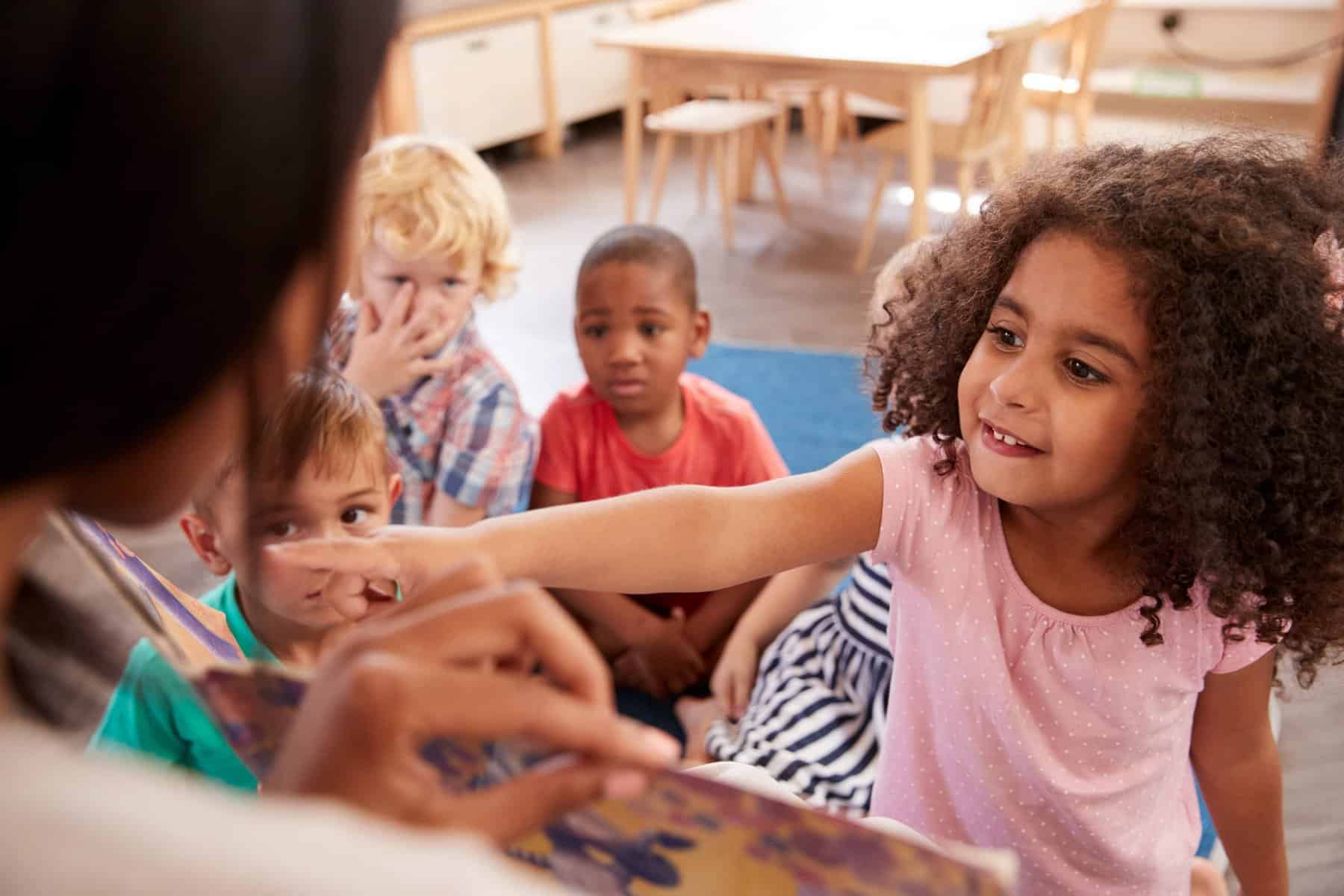
Some kids often refuse to read. Either the content or the format of the books doesn’t interest them, or maybe they don’t see the point of reading. However, by practicing the Montessori reading method, it becomes a fun, proactive and engaging experience.
There’s a variety of factors that you have to consider so as to make it fun. First of all, the resources you provide should be age-appropriate. If you’re using books, make sure that the topics are fun and that they’re not too easy or too overwhelming for children to read.
Most of all, as the Montessori reading style explains, parents and teachers have to create positive and interesting learning environments. In other words, kids have to learn to read independently. By doing it this way, you actively stimulate their thirst for knowledge.
To put it simply, the final goal of teaching words and letters the Montessori way is not to help children learn how to read – but to help children develop a lifelong love for books.
It may at first seem impossible when dealing with a fussy kid that refuses to read, but these kinds of activities are specifically designed to keep their interest. With a selection of interesting books and written materials, children fall in love with writing and reading.
However, to help kids really fall in love with words, the Montessori method thoroughly explains that it’s not only about teaching letters and words and phonetics – but about stimulating their imagination and providing engaging activities that demand creativity.
In other words, kids that proactively delve into their imagination with the purpose of expressing themselves are also more eager to read so as to refine their vocabulary skills.
Basically, creative expression plays a crucial part in the Montessori reading method.
When parents attempt to teach their kids how to read, they often overlook the importance of meaning. Every word and letter means something. In a way, children have to perceive language as a way to explore, navigate and make sense of the world around them.
Therefore, by providing language-enhancing activities that utilize a hands-on approach, teachers directly inspire not only a love of literature – but a love of knowledge.
Phases of Montessori Reading Development

Whether at home or at a classroom, the Montessori reading approach consists of several phases of development, specifically designed for natural development of language skills.
The Montessori reading method includes the following phases:
- The Preparation Phase
- The Sensorial Phase
- The Readiness Phase
- The Fluency Phase
- The Meaning Phase
1. During the preparation phase, children are patiently and gradually introduced to symbols and sounds. At the very beginning, it’s important for children to understand how to correlate a letter with its corresponding sound as they develop phonemic awareness.
Gradually, books are introduced, as well. Activities such as storytelling take place, too. This allows for teachers and parents to assess the child’s abilities and any strengths or weaknesses as they figure out an ideal individual approach for vocabulary development.
2. After the preparation phase, the sensorial phase begins. Things are taken to another level by using Montessori assets such as sandpaper letters and movable alphabets.
The idea behind the sensorial phase is to activate the children’s senses. This is where the Montessori reading method thrives by implementing a stimulating, hands-on approach.
3. The readiness phase begins when a child is ready to start decoding words and simple sentences. Bear in mind that in the Montessori method, students first learn to write and then to read. However, the readiness phase tests and refines their comprehension.
When presenting new materials or lessons, the Montessori method utilizes the three-period lessons. This technique helps kids grasp new materials in a gradual manner.
The readiness phase means that a lot of progress has been already made. As such, kids take part in more complex activities like practicing writing and creative expression exercises.
4. In the fluency phase, children are able to read coherently, fluidly and able to form and read complex sentences. This is when you start to introduce next-level lessons and resources such as sandpaper numbers and reading charts, among other useful utilities.
Having mastered how to read to a reasonable degree, kids move on to more complex tasks – such as understanding grammar and expanding their vocabulary, delving into the structure of their writings and sentences, all while enjoying more and more freedom.
5. The last phase – the meaning phase – implies that kids have practically mastered reading. Now, it’s a matter of diving into words and letters with new and complex Montessori materials in order to practice critical thinking and more profound analysis.
In other words, children are now looking for underlying meanings and further developing their language skills. On top of that, they’re taking part in more comprehensive exercises.
Following these phases is key, because they are specifically designed to be gradual. They take into account that every kid develops at their own pace. But, by introducing these phases slowly and gradually, they prepare children in a friendly, underwhelming manner.
Montessori Reading Materials and Tools
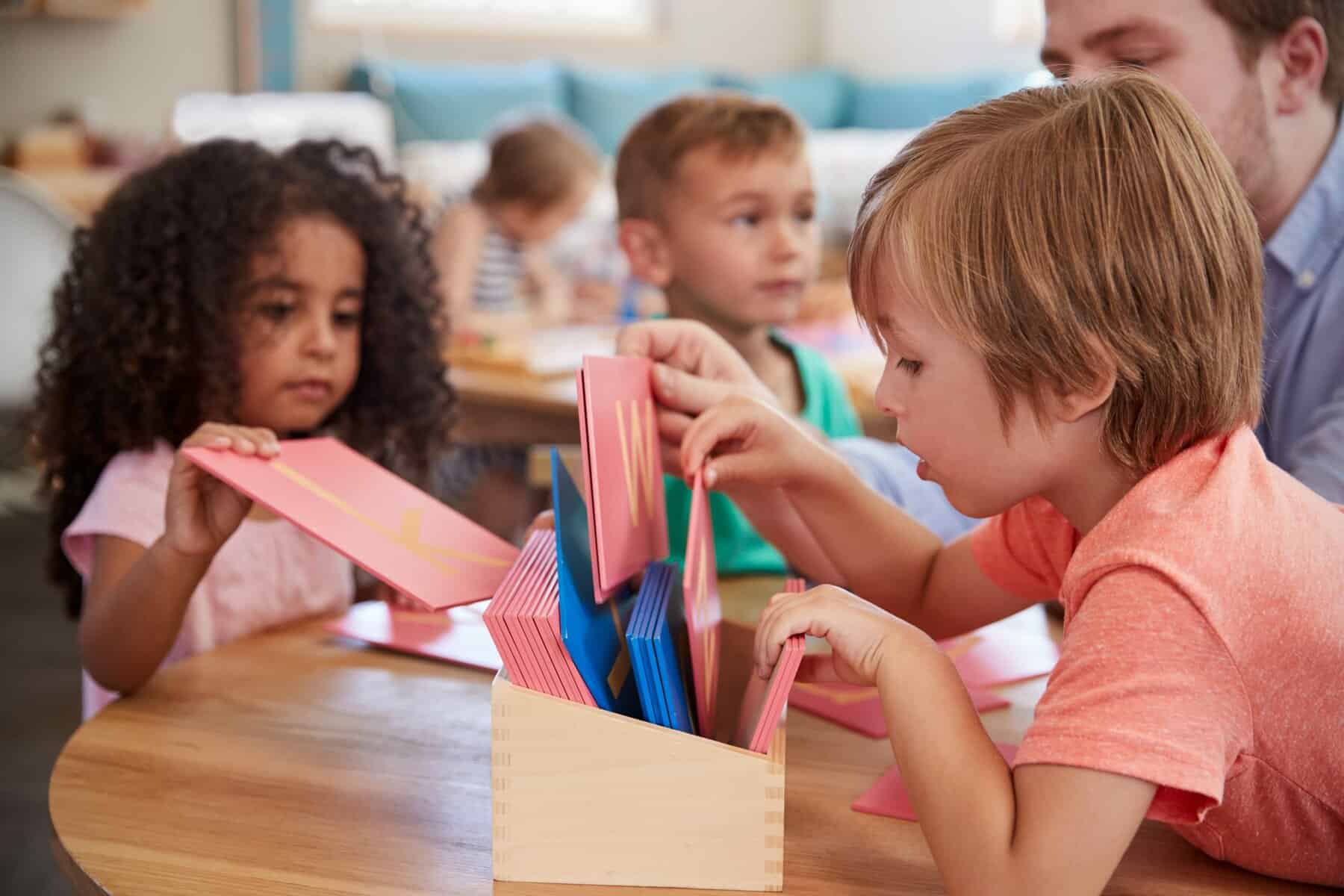
The Montessori method requires the use of specialized resources.
The tools teachers and parents utilize support the learning process. All of these external resources are specifically designed to be engaging. Other than that, the way they’re engineered allows a child to experience them without the need for much parental input.
Let’s briefly examine the most common tools utilized:
1. The use of sandpaper letters is crucial in teaching kids to read. Naturally, sandpaper letters are made from, well, sandpaper – and their usefulness comes from the fact that they activate a child’s sense of touch, helping them improve their phonemic awareness.
2. A common tool used at home or at school – sandpaper numbers work to stimulate senses, familiarizing kids with numbers and sequences in a natural and effective way.
3. The Montessori method requires the use of a movable alphabet, wooden letters that kids can freely move around and manipulate with the final purpose of creating words.
4. In a Montessori school, teachers utilize what is known as the three-period lesson. Basically, the three-period lesson implies a structured approach, a particular order by which kids are introduced to a specific word, starting from a sound in and of itself.
5. A Montessori phonogram has the purpose of helping kids understand the relationship between a sound, a symbol and a word. Basically, phonograms are letters or a combination of letters that represent a sound – an exercise that has proven to be very effective.
6. Finally, a Montessori classroom isn’t complete unless it’s stocked with a variety of age-appropriate books. These books are interesting, engaging and oftentimes interactive, too.
These tools and assets combined make for a diverse educational experience. Specifically designed to offer engaging challenges, with the use of these tools, kids are able to progress naturally and independently from simple tasks to complex exercises and assignments.
Montessori Activities to Help Kids Read
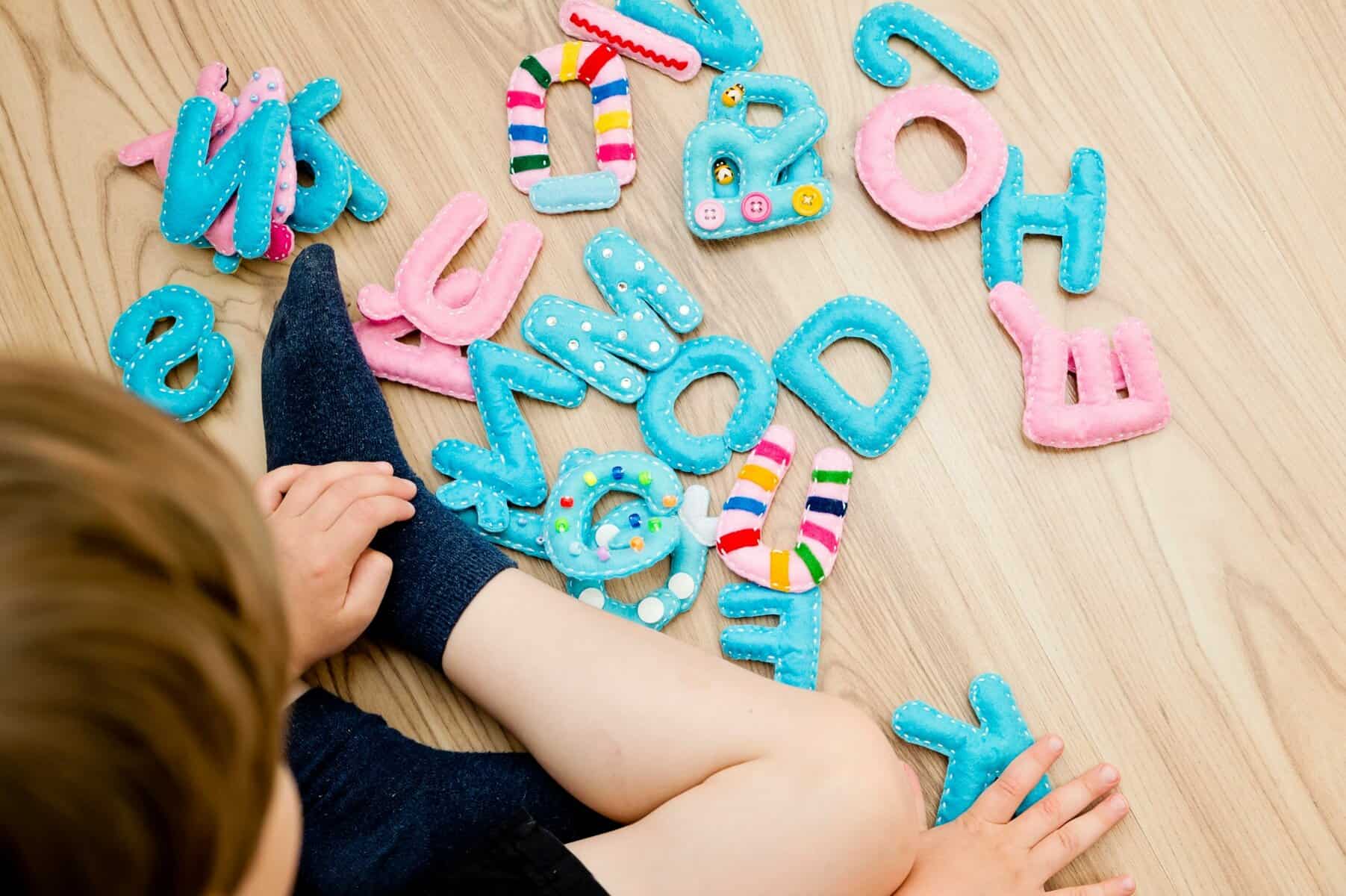
Teaching a child to read demands fun, engaging and age-appropriate activities.
The right kind of tasks and growth opportunities cultivate a child’s love for literacy. The fun and productive excitement they experience now translates into a lifelong passion.
Let’s review some developmentally appropriate activities that encourage discovery:
1. Sound baskets make for a great activity that teaches a child how to connect a sound to a letter. It’s very simple to play and very engaging. You make a basket for every letter of the alphabet. Then, you fill them up with pictures that start with the letter’s sound.
2. Learning words with senses is another great activity. Every time a child learns a new word, the word ‘orange’ for example, have them touch and feel an actual orange in order to help them associate the word with the object, which promotes sensory exploration.
3. Teaching reading to kids is sometimes a matter of learning how to write. By including various writing exercises, such as writing letters, words and sentences – with or without using Montessori resources – you promote their ability to read and understand words.
4. In a Montessori classroom, a child needs to be creatively stimulated. To be exact, a child needs enough freedom and opportunities to express their imagination freely. With storytelling exercises, you promote language development and nourish their confidence.
The tools and resources at your disposal are closely linked with the kind of activities that you will be practicing in a Montessori classroom or at home. Speaking of which, teaching your child to read and write can be done from the safety and comfort of your home.
Supporting the Montessori Method From Home
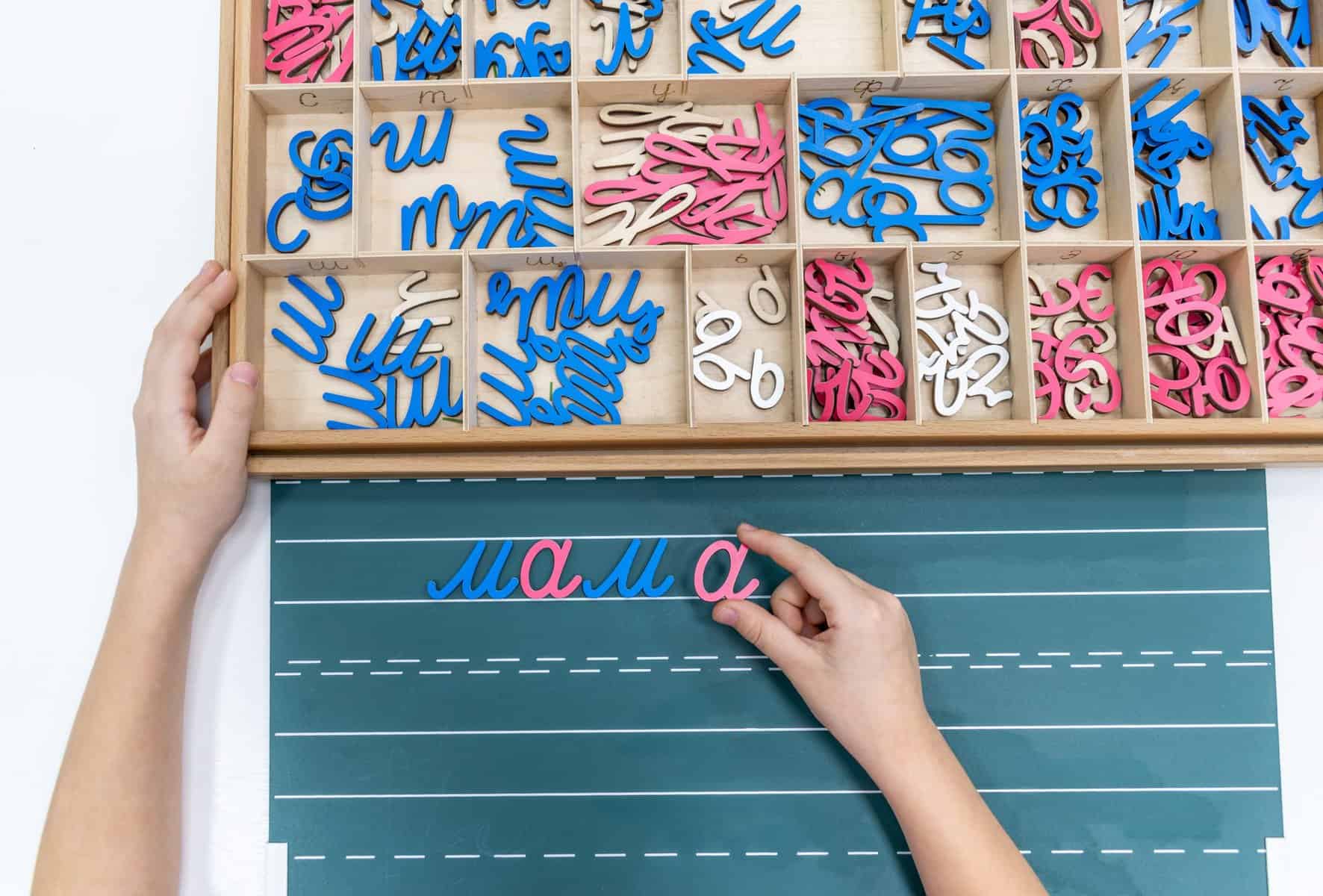
Ideally, practicing the Montessori method at home should go hand-in-hand with your child learning and developing in a Montessori school. In fact, we would go so far as to say that it is crucial for parents to incorporate Montessori’s philosophy inside their home.
But how? Well, the first thing you want to do is to create a book-rich environment inside your home. This allows your child to have continuous access to useful resources that improve their ability to read. Create a shelf just for developmentally appropriate books.
At home, you can read together. In fact, it would be good if you made it a routine. Find the time to incorporate story time into your daily routine over which you can bond.
Gradually, increase the difficulty and the complexity of literature.
However, the Montessori method is all about individuality. So, make sure to encourage your child to read independently. This doesn’t mean that you shouldn’t respond to your child’s needs and questions, but give them enough freedom and space for exploration.
Even though you’re home, bear in mind that you can still use Montessori resources.
As your child learns to read, make sure to include writing exercises, as well. Above all else, be patient and understanding. Remember that every child develops at their own pace.
In Conclusion

All things considered, the Montessori reading method implies a comprehensive hands-on approach to learning that utilizes a variety of developmental tools in order to inspire, ultimately, a lifelong love for books, literature and, above all else, a thirst for knowledge.
Do well to support the method by creating an engaging and developmentally appropriate environment inside your home, as well. For the Montessori reading method to work, children need to continue developing their skills and love for books at home, too.
Even though the Montessori method may not suit every parent, it’s a unique and effective hands-on approach to learning that can set your children on a path towards a practical life. The benefits of the method build a strong foundation for a successful, independent child.

Mother of three and a primary school teacher. I’ve always loved being around children and helping them, so I chose my path as a teacher. It is sometimes hectic with three children, but I am 100 percent into it and wouldn’t change it for anything in the world.

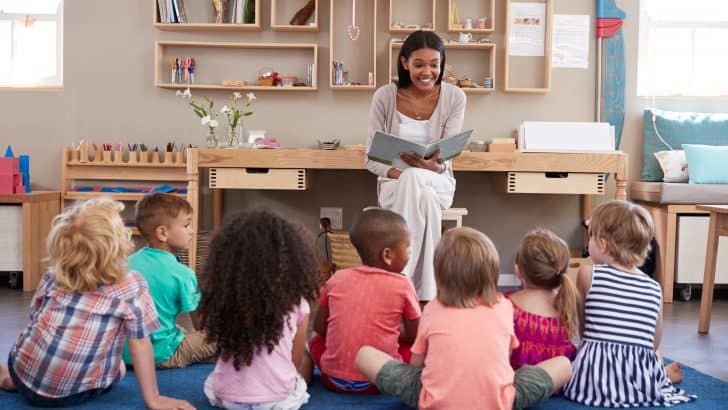
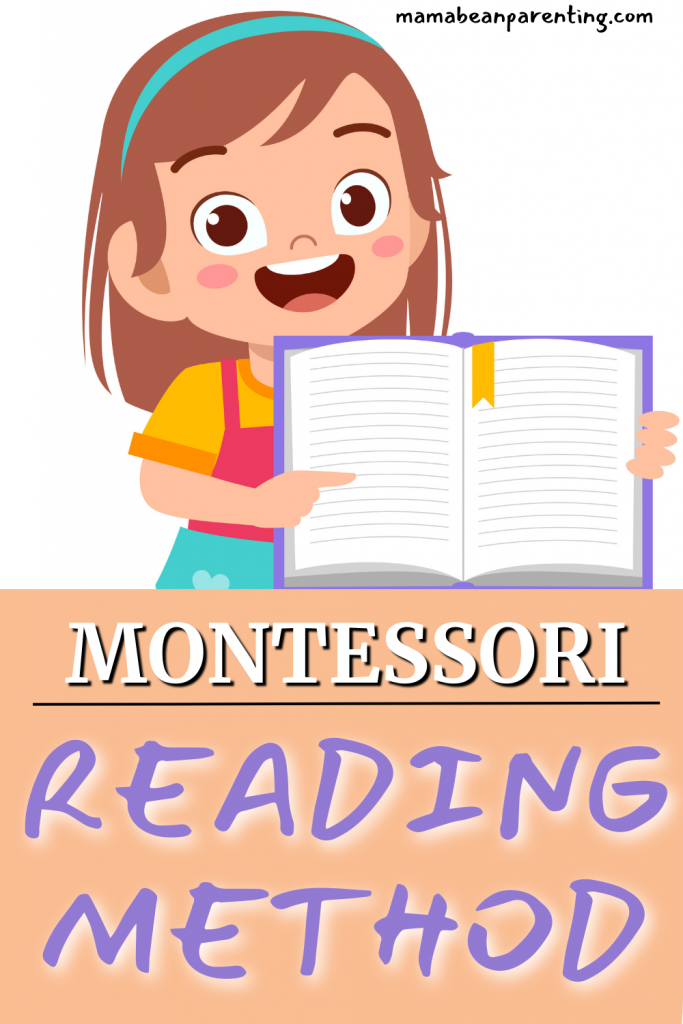
9 Show and Tell Ideas for Kindergarten • Mama Bean Parenting
Friday 24th of February 2023
[…] Some kids refuse to read. This happens for a variety of reasons, but if your child talks about why they enjoy reading the book, it can influence their peers in a positive way. […]
Montessori DIY Toys: 9 Creative and Effective Ideas • Mama Bean Parenting
Friday 10th of February 2023
[…] of education works efficiently only if the children have access to fun and engaging materials. From learning to read to developing social skills, the use of Montessori materials – such as Montessori DIY toys […]